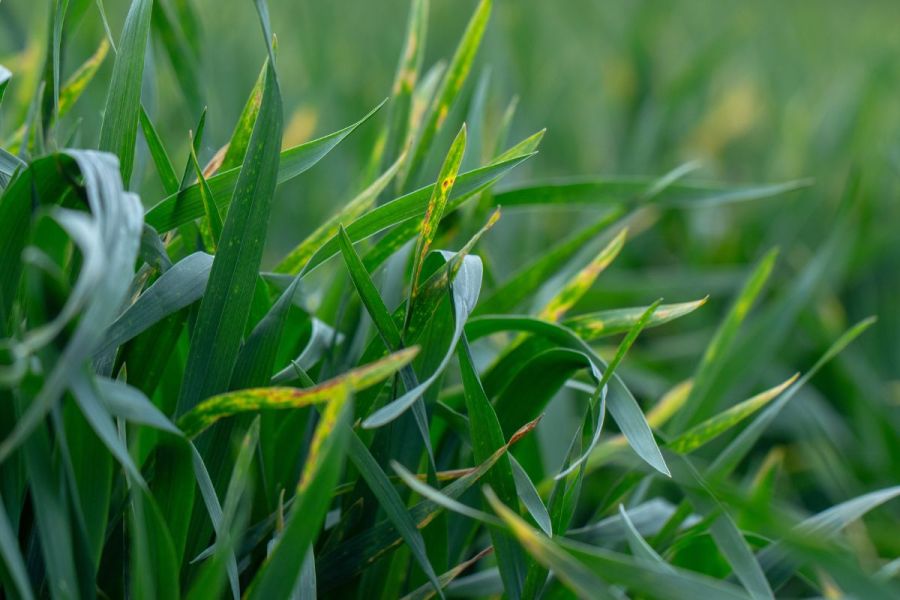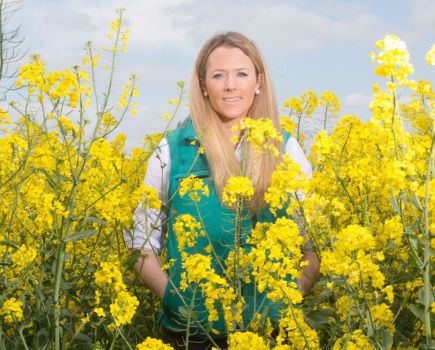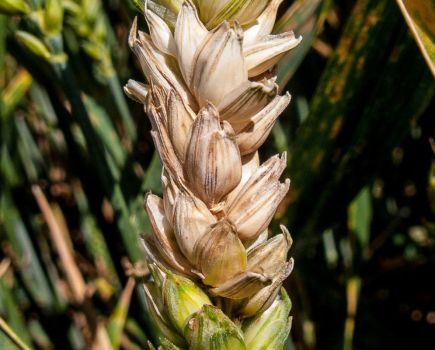Achieving resilient disease control relies on many independent factors coming together under the stewardship of growers and agronomists. In the first of BASF’s Real Results Roundtables, CPM hosts an open discussion to understand the current state of play.
“Using the lowest effective recommended dose rate is always the best approach for resistance management.”
By Janine Adamson
North Essex-based Steve Crayston’s family farms two separate blocks of land totalling 1,000ha alongside his uncle and cousin. He’s been involved with BASF’s Real Results Circle since 2019, conducting a range of trials across the mostly medium to heavy clay land.
Steve’s cropping rotation at JR Crayston & Sons includes winter wheat, oilseed rape, spring barley, spring oats, maize, sugar beet and two more unusual crops – borage and echium.
For this Roundtable, he’s joined by NIAB’s senior specialist for crop protection and IPM, Dr Aoife O’Driscoll; BASF’s business development manager, Jared Bonner; and BASF’s agronomy manager for the East & Central region, Andrew Smooker.
The topic being discussed is resilient disease control – from variety selection to fungicide resistance management, and all in between.
Variety selection and drilling date
Opening up discussions for the Roundtable began with Steve explaining that most importantly, before thinking about wider traits such as disease resistance, an end market has to be secured. “We’ve found that with some popular varieties, they’re fabulous agronomically speaking, but there isn’t necessarily a great home for them, so they land up being medium performing and yielding feed wheats,” he said.
“But then, disease resistance comes into play, particularly for rusts and septoria. That has to be the starting point for us given our location in north Essex.”
In response, Andrew asked Steve how much weight he places on disease ratings or whether he prefers to take prophylactic action, particularly for rust. To answer, Steve said he wants to see a good starting point within the variety’s genetics, but follows with a robust programme including all crops receiving a T0 spray. This is with a view to genetics and chemistry working together.
“Applications vary depending on seasonal risk. We have a plan based on what’s cost effective and will deliver a return, but it doesn’t mean that happens in reality,” he said.
In more typical years, Steve aims to start drilling during the last week of September, depending on weather conditions. “We’ve just about managed to plant the majority of our crops this season bar around 4ha which has been left undrilled.
“Some look good, others not so – all fields seem to have some level of compromise. The earlier crops generally look well, particularly those following borage in the rotation whereas direct drilling after maize doesn’t seem so healthy,” he explained.
Fungicide timings and doses
Having heard that Steve’s wheat crops are sprayed at T0, Aoife asked whether there’ll be variability in fungicide timings or whether the aim is to be precise and then possibly adjust rates.
Steve said he believes timing will be a huge problem this year because crops are all over the place. “We tend to consider the field average and won’t change what’s actually applied. That’s because we’re block cropping, so once working in a particular area, it has to be as simple as possible,” he said.
Candidly, Steve explained that if he left a hectare or two unsprayed, it’s likely he’d never get back around to treating the area because it takes around four days to travel all of the farm’s wheat crops. He’s also unlikely to reduce rates for specific areas which appear to have less potential, due to concerns about compromising product efficacy.
Steve added that he doesn’t leave any crop untreated and prefers to have a robust approach to risk management. However, with products such as Revystar XE (mefentrifluconazole+ fluxapyroxad), he does adjust rates between 0.6-1.0 l/ha depending on the variety, crop potential, anticipated disease pressure and timings
In reply, Jared provided his thoughts on dose management: “Using the lowest effective recommended dose rate is always the best approach for resistance management,” he said.
“Repeatedly using full doses over and over can in fact increase selection pressure and not reduce it, which is different to other resistance models such as with herbicides. So to hear that you’re using the most appropriate dose for the situation shows you have consideration for protecting that and other chemistry.”
Aoife said that Steve’s approach of helping to protect the genetics with a considered fungicide programme is a positive message.
Spray programmes
This year’s fungicide programme at the farm has been devised based on the best chemistry available, the price and by calculating gross margins, explained Steve.
“This season yields will be down so it’s difficult to know exactly what to do – whether to throw everything at a crop or scale back accordingly based on potential,” he explained. “If we can produce a 10-12t/ha crop of wheat but it’s cost too much money to get there, then it’s a waste of time.”
Steve shared that his plans include a T0 across all wheat which is usually tebuconazole plus a PGR. He’s then looking at Vimoy (isoflucypram) or Revystar at T1. Folpet as a multi-site is also a key component, which he’ll use twice at 1.0 l/ha.
“I find that Revystar slots into T1 or T2 depending on the variety, seasonal conditions and what’s been used in the programme prior to that. Currently we plan to use Revystar at the T2 position this year,” said Steve. “99% of the time we’ll use a T3 with tebuconazole in it; I take a belt and braces approach.”
To respond, Aoife said she doesn’t perceive Steve’s programme as belt and braces, instead a rather sensible and considered approach to a fungicide programme. She then asked if he uses plant health products and what else he considers intrinsic to successful disease control.
“Getting on early with fertiliser is key to ensuring a strong, healthy crop with good rooting. The stronger the plant, the more tolerant it is of disease.
“We apply sewage sludge and digestate which contribute to overall nutritional requirements. We don’t use wider plant health products at the moment as I don’t feel we know enough about them,” he acknowledged.
To help inform fungicide choices and wider spray programmes, Steve said trials have assisted in decision making. “Taking part in on-farm replicated trials provides a lot of useful information. As well as the Real Results Circle, we’ve also been involved in ADAS YEN (Yield Enhancement Network).”
Revystar XE considerations
Jared raised the point of Revystar XE’s greening benefits at T2 and asked Steve whether he believes the product fits well with his farm.
“Based on our own on farm trials, we’ve seen a yield increase with Revystar over the past couple of years. We feel that it gives us a good greening effect and is a different mode of action which is extremely important. I also appreciate its rainfastness which is useful during catchy years,” replied Steve. “However, I’ve not had a chance to test that theory because we aim to apply it during the correct conditions.”
Jared expanded on the fact that Revystar XE is a sub-class of azole, but stressed that using diverse modes of action is critical. “Revystar has unique characteristics and is the most effective azole against septoria, which is important for resistance management; it’s vital to safeguard that chemistry by using all of the available tools. It protects not just BASF’s chemistry, but that of the whole industry,” he said.
Aoife agreed, emphasising the importance of using different actives within a spray programme as part of an overall resistance management strategy. “Azoles play an important role in protecting other chemistry and Revysol is the strongest azole for septoria control.
“However, ensuring the use of different modes of action as well as different azoles spread across the programme is key for resistance management.”
Jared then mentioned that another benefit of Revystar XE is that it offers broad spectrum disease control, beyond just septoria. “It has good activity against yellow and brown rusts as well as eyespot, so hopefully it ticks those boxes too from an on-farm perspective.”
In response, both Steve and Aoife said that they’d seen a lot of yellow rust in crops this year. And although there have been widespread reports of brown rust, Steve said it wasn’t a disease he’d experienced this season yet.
Wider resistance management
Aoife asked Steve how much he currently understands about the disease resistance status on his farm and whether information from research organisations is being successfully filtered down.
He replied and said truthfully, he doesn’t know a lot. “As farmers, we have a lot of information to keep on top of and tend to have broad knowledge. I place a lot of trust in my independent agronomist to understand those sorts of things.”
Aoife appreciated Steve’s honesty and said farmers are more likely to understand the resistance status of weed species rather than disease, due to being encouraged to send samples for testing.
But on a positive note, Andrew said farmers have a good range of tools in the toolbox this season, so it’s more about implementing best practice to ensure those products have a sustainable future.
Additional thoughts
During discussions, Aoife raised the issue of juvenile versus adult varietal resistance with brown and yellow rust. “At the juvenile stage, nearly all of the varieties on the AHDB Recommended List are susceptible to brown rust, so it’s not unusual to see at the moment. There may have been issues with misidentification in the past whereby it was assumed to be yellow rust,” she stressed.
“For many varieties brown rust will become less of an issue as plants gain their adult resistance status, however, susceptible varieties still have to be monitored.
“It’s yellow rust where varieties offer different resistance levels in the juvenile plant. There have been a lot of reports of certain varieties with high levels of rust, and farmers considering a pre-T0 spray. This isn’t something we’d recommend, mind, preferring to opt for an early T0.”
With spray timings having also been identified as a critical factor for this season, Andrew pointed out that visual assessments alone may not be sufficient in identifying crop growth stages, as backward plant growth stages and typical leaf emergence may be out of sync. “Dissecting plants in the field is going to be very important to help to ensure fungicide timings are applied to the correct leaf layers,” he concluded.
This article was taken from the latest issue of CPM. Read the article in full here.
For more articles like this, subscribe here.
Sign up for Crop Production Magazine’s FREE e-newsletter here.




